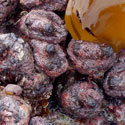Tunicata or Urochordata (tunicates, sea squirts, doliolids,
salps)
Life > Eukaryotes > Opisthokonta > Metazoa
(animals) >
Bilateria > Deuterostomia > Chordata
Classification
|
Ascidiacea (sea squirts)
Twenty-six families, 167 genera and 2852 species
worldwide, with 16 familes, 53 genera and 176 species native to
southern African seas and a further family, genus and seven species
naturalised in the region. Thus, 6.2 % of the world's sea squirt
species have been recorded as native species from southern African
seas. |
 |
|
Larvacea (larvaceans, appendicularians)
[= Appendicularia]
Three families, 14 genera and 68 species worldwide, with all three families,
11 genera and 42 species (61.8%) that that have broad distributions that include
southern African seas. There are no endemic species in the region. |
|
|
Thaliacea (salps, doliolids, fire rollers)
Five families, 25 genera and 79 species worldwide,
with three families, 20 genera and 52 species that that have broad
distributions that include southern African seas. There are no
endemic species in the region. |
 |
Publications
- Bone Q, Carré C, Chang P. 2003. Tunicate feeding filters.
Journal of the Marine Biological Association UK 83: 907-919.
- Day RW. 1974. An investigation of Pyura stolonifera
(Tunicata) from the Cape Peninsula. Zoologica Africana 9:35-58.
- Griffiths RG. 1976. The larval development of Pyura
stolonifera (Tunicata). Transactions of the Royal Society of
South Africa 42: 1-9.
- Kott P. 2005. Pycnoclavella (Tunicata: Ascidiacea)
species from the West Indian Ocean. African Zoology, 40(2):
205-212
- Fenaux R., Bone Q, and Deibel D. 1998. Appendicularian
distribution and zoogeography, p. 251-264. In Q. Bone [ed.], The
biology of pelagic tunicates. Oxford University Press.
- Andersen V. 1985. Filtration and ingestion rates of Salpa
fusiformis Cuvier (Tunicata: Thaliaceea): effects of size,
individual weight and algal concentration. J. Exp. Mar. Biol.
Ecol. 87:13-29.
- Andersen V. 1986. Effect of temperature on the filtration
rate and percentage of assimilation of Salpa fusiformis Cuvier
(Tunicata: Thaliacea). Hydrobiologia 137:135-140.
- Andersen V. 1989. Phosphate excretion rate of Salpa
fusiformis Cuvier (Tunicata: Thaliacea). Hydrobiologia
171:91-97.
- De Decker A. 1973. Agulhas Bank plankton. p.189-219. In B.
Zeitschel (ed.) The Biology of the Indian Ocean. Springer,
Berlin. [salp swarm dynamics]
- Deibel D., and Lowen B. 2011. A review of the life cycles
and life-history adaptations of pelagic tunicates to
environmental conditions. – ICES Journal of Marine Science,
doi:10.1093/icesjms/fsr159.
- Lazarus, B. I. and D. Dowler. 1979. Pelagic tunicata off the
west and south-west coasts of South Africa, 1964-1965. Fish.
Bull. S. Afr. 12:93-119.
- Sewell SRB. 1953. The pelagic tunicates. Juhn Murray
Expedition 1933-34, Scientific Rep. Brit. Mus. Nat. Hist.
10:90p. [salp swarms off South Africa]
- Van Zyl, R. P. 1960. A preliminary study of the salps and
doliolids off the west and south coasts of South Africa.
Investigational Rept. Div. Fisheries, Union of South Africa.
v.40, 31p.
- Perissinotto R, Mayzaud P, Nichols PD and Labat JP. 2007.
Grazing by Pyrosoma atlanticum (Tunicata, Thaliacea) in
the south Indian Ocean. Marine Ecology Progress Series 330:
1-11. Pyrosomas are colonial tunicates capable of forming dense
aggregations. Their trophic function in the ocean, as well as
their ecology and physiology in general, are extremely poorly
known. During the ANTARES-4 survey (January and February 1999)
their feeding dynamics were investigated in the south Indian
Ocean. Results show that their in situ clearance rates may be
among the highest recorded in any pelagic grazer, with up to 35
1 h(-1) per colony (length: 17.9 4.3 SD cm). Gut pigment
destruction rates, estimated for the first time in this tunicate
group, are higher than those previously measured in salps and
appendicularians, ranging from 54 to virtually 100% (mean: 79.7
19.8 of total pigment ingested. Although individual colony
ingestion rates were high (39.6 17.3 SD mu g pigment d(-1)), the
total impact on the phytoplankton biomass and production in the
Agulhas Front was relatively low, 0.01 to 4.91% and 0.02 to
5.74% respectively, as a result of the low abundance of
colonies. Colonies showed higher retention efficiency for
particles larger than 10 mu m. Low levels of lipids and
percentages of triacylglycerols and free fatty acids were found
in zooids. Markers for diatoms (C16 PUFA), dinoflagellates
(22:6n-3, 18:5n-3) and prymnesiophytes (18:1n-9, 18:4n-3) were
observed. Stepwise discriminant analysis of published data on
phytoplankton fatty acid showed a strong similarity between the
composition of the 2 neutral lipid classes found in P.
atlanticum and that of both dinoflagellates and prymnesiophytes.
The sterol composition confirmed this result with the
contribution of 24-methylcholest-5,22-dien-3 beta-ol,
cholesterol, 24-methylenecholesterol and 24-ethylcholesterol.
Colonies exhibited large numbers of ciliate protozoans (possibly
Strombidium sp.). It is not clear whether this constituted a
mere opportunistic intrusion, or rather a more stable
association between the 2 organisms.
- Gibbons MJ. 1997. Vertical distribution and feeding of
Thalia democratica on the Agulhas Bank during march 1994.
Journal of the Marine Biological Association of the United
Kingdom 77(2): 493-505. Diel vertical migration (DVM) and in
situ feeding of Thalia democratica (Tunicata: Thaliacea) was
studied in the field (Agulhas Bank, South Africa) over a 48 h
period in March 1994. Thalia democratica did not display DVM,
and both aggregates and solitaires were mostly confined to the
upper layers of the water column throughout the study period.
Thalia democratica did not display any discernible diel feeding
rhythm, and pigment content increased with salp size.
Individuals with greatest pigment content were found at the
chlorophyll maximum. Estimates of grazing impact varied with
salp abundance and gut passage time, ranging from less than 1%
to greater than 100% of phytoplankton productivity.
- van Soest RWM. 1972. Latitudinal variation in Atlantic
Salpa fusiformis Cuvier, 1804 (Tunicata, Thaliacea).
Beaufortia 20: 59-68.
- van Soest RWM. 1973. The genus Thalia Blumenbach,
1798 (Tunicata, Thaliacea), with descriptions of two new
species. Beaufortia 271(20): 193-212.
- van Soest RWM. 1981. A monograph of the order Pyrosomatida
(Tunicata, Thaliacea). Journal of Plankton Research 3(4):
603-631.
Text by Hamish Robertson |
